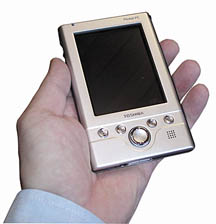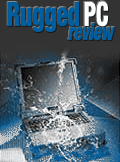Toshiba e335 Pocket PC
New processor, twice the memory, lower price
(Pen Computing Magazine, December 2002 issue) --
Sometimes things move so fast that it's hard to keep up. Only a couple of issues ago (Pen Computing Magazine, June 2002, page 74) we introduced Toshiba's Pocket PC e310 and raved about what a superb value it was: for just US$399 you got a full-fledged, full-power Pocket PC with all the trimmings. Now, just a few months later, the e310 is already old hat and has been replaced by a better deal yet, the brand-new Toshiba Pocket PC e335. When I say "old hat," however, I do not mean that those of you who bought an e310 should tear your hair out. This is not a situation where a product is replaced with something entirely new that costs half as much and is twice as good. In fact, the new e335 looks exactly the same as the e310 it replaces. With the exception of the new model designation printed onto the backside of the unit the two look identical.
 The differences between the e310 and the e330 series are entirely under the hood. Toshiba replaced the 206MHz StrongARM CPU with a 300MHz Intel XScale PXA250 Application Processor, added another 32MB of RAM for a total of 64MB, lowered the price from US$399 to US$349, and threw in the ArcSoft PhotoBase for Pocket PC imaging application. All of this means that you do get more for less, but the difference isn't really all that substantial. Prices of computers come down all the time, and in this case you get a newer processor and twice the RAM for US$50 less. In the overall scheme of things, the new e335 is as attractive a deal as the e310 was earlier in 2002.
The differences between the e310 and the e330 series are entirely under the hood. Toshiba replaced the 206MHz StrongARM CPU with a 300MHz Intel XScale PXA250 Application Processor, added another 32MB of RAM for a total of 64MB, lowered the price from US$399 to US$349, and threw in the ArcSoft PhotoBase for Pocket PC imaging application. All of this means that you do get more for less, but the difference isn't really all that substantial. Prices of computers come down all the time, and in this case you get a newer processor and twice the RAM for US$50 less. In the overall scheme of things, the new e335 is as attractive a deal as the e310 was earlier in 2002.
Needless to say, twice the RAM always comes in handy, and the e310's smallish 32MB of RAM was one of the features we criticized in our earlier review. You can, of course, store data on a SD or MMC card as both the e310 and the new e335 have a SD card slot, but having onboard memory is always better. The new unit's 64MB is therefore definitely a big improvement.
On the CPU side, after having powered numerous devices for several years, the ubiquitous old StrongARM (going all the way back to the Apple Newton MP2000) is now being replaced by the next-generation XScale processors. These are based on the ARM version 5 architecture (the StrongARM was based on version 4) which has improved memory utilization via a process called Thumb code-compression technology. The PXA250 used in the e335 also has 32kb data and instruction caches as opposed to 16 and 8kb, and there are now low power and turbo modes for either performance or long battery life. Between those advancements, and the fact that the new processor runs at 300MHz instead of 206MHz, you'd expect substantial performance improvements. However, although XScale is compatible with the older StrongARM code, only new software can take full advantage of the many new features built into XScale. The new chip includes many more integrated controllers and peripherals as well as greatly enhanced multimedia potential via signal processing technologies, and we'll probably see the benefit of that in future devices.
As is, there really isn't a noticeable performance difference between the e310 and the e335. In fact, side by side, almost all applications seem to start up somewhat quicker on the older machine. That is likely because none of the current Pocket PC software has been written to take advantage of the new version 5 architecture. Also, while the e310 has an elaborate power settings control panel, I didn't find anything that relates to the XScale's different power modes, so the switching between turbo and economy may be automatic.
In terms of specs, the e335 remains one of the smaller and lighter Pocket PCs with a footprint of 4.9 x 3.1 inches, a thickness of 0.4 inches, and a weight of 5.1 ounces. The 3.7V/1,000mAH internal Li-Ion battery should provide longer life than in the e310 as the PXA250 processor is significantly more energy-efficient than the StrongARM, especially under load. All the controls and buttons are Pocket PC standard, with two application buttons flanking a central navigation disc. Those are complemented by a rocker and an audio recorder button on the left. The on/off switch is on top which also contains the stylus garage, the IR port, a stereo jack, and the e335's SD/MMC card slot. The e335 comes with a heavy dock that has a five feet long USB cable. The AC adapter connects either to the dock or directly into the device, a good arrangement. On the display side, the e335 sports a reflective 3.5-inch TFT with a frontlight mounted along the short side of the display. As nice as that display is, technology has marched on and we now prefer the new transflective displays used in the new high-end iPAQs and even in the ViewSonic V35 reviewed in this issue.
On the software side, the e335 comes with the standard Pocket PC 2002 apps which address just about any need. In addition, the e335 comes with ArcSoft's PhotoBase for Pocket PC, a neat image viewing and cataloging application that merits its own review. You can use it to view, organize, or edit your pictures, do slideshows, and even email or beam pictures. Thanks, Toshiba!
Overall, the e335 once again shows Toshiba's determination to provide both value and advanced technology in the PDA space. Twice the memory at a lower price can't be beat, and while we have yet to see the eventual benefits of the new PXA processors, it's certainly good to have it under the hood, if only for its promise of more battery life. The only fly in Toshiba's ointment is the new ViewSonic with its transflective display and even lower retail price, albeit minus ArcSoft's handy image viewer. The race never ends.
Contact: Toshiba www.toshiba.com
|


 The differences between the e310 and the e330 series are entirely under the hood. Toshiba replaced the 206MHz StrongARM CPU with a 300MHz Intel XScale PXA250 Application Processor, added another 32MB of RAM for a total of 64MB, lowered the price from US$399 to US$349, and threw in the ArcSoft PhotoBase for Pocket PC imaging application. All of this means that you do get more for less, but the difference isn't really all that substantial. Prices of computers come down all the time, and in this case you get a newer processor and twice the RAM for US$50 less. In the overall scheme of things, the new e335 is as attractive a deal as the e310 was earlier in 2002.
The differences between the e310 and the e330 series are entirely under the hood. Toshiba replaced the 206MHz StrongARM CPU with a 300MHz Intel XScale PXA250 Application Processor, added another 32MB of RAM for a total of 64MB, lowered the price from US$399 to US$349, and threw in the ArcSoft PhotoBase for Pocket PC imaging application. All of this means that you do get more for less, but the difference isn't really all that substantial. Prices of computers come down all the time, and in this case you get a newer processor and twice the RAM for US$50 less. In the overall scheme of things, the new e335 is as attractive a deal as the e310 was earlier in 2002.